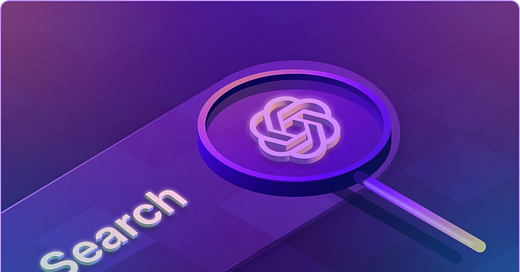SearchGPT: 5 early insights
I got my hands on OpenAI's search tool prototype — here are my initial thoughts.
Beth here, VP of Organic Media at global performance marketing agency Journey Further.
As ChatGPT will tell you with its characteristic cheerfulness, digital media is a "rapidly evolving landscape." Google is regularly updating its algorithm, AI is getting smarter by the day, and new tools are entering the market faster than fashion trends go in and out of style. That can spell both opportunity and challenge for us marketers.
One of the most talked-about updates to the search landscape is OpenAI’s SearchGPT — a product currently in prototype mode that could threaten Google’s dominance. At Journey Further, we gained access to SearchGPT last week. Our initial impressions are positive; it certainly outperforms Google's AI Overviews right now (though that's not saying much).
Here are five initial takeaways about this new tool and its implications:
An expanding search ecosystem is a good thing. While SearchGPT may result in fewer clicks for informational terms — and mostly for low-intent searches — in my opinion, this shift broadens the search ecosystem and opens new doors for marketers to connect with customers beyond traditional Google SERPs.
Search is about to become more conversational. SearchGPT's natural language processing capabilities allow for more nuanced, dialogue-like interactions. This means keyword research is likely to change dramatically.
Earned media will remain important. SearchGPT seems to prioritize high-authority publications, meaning digital PR and thought leadership may become even more powerful. What's more, at least right now, SearchGPT seems to link out to content creators more than Google does. If this sticks, it may offer brands increased opportunities to boost awareness and traffic.
Visibility tracking will evolve. To adapt to this new landscape, marketers should consider tracking visibility through prompts and brand mentions rather than traditional rankings.
Consistent optimization will be key. At Journey Further, our approach to optimization remains mostly unchanged. High-quality, relevant content is essential for engagement and a competitive edge.
It’s early days, but we're advising our clients that standard SEO best practices still apply. At the moment, it seems likely that OpenAI will prioritize authoritative publisher content over brand websites to answer queries — so companies that aren’t investing in high-quality media coverage or digital PR may want to add those strategies to their 2025 budgets.
After all, you don’t want to miss out on this “fast-paced evolution.”
The AI Hype Matrix maps the latest AI news stories across an unimpeachable scale of Hype (everyone is talking about this!) and Fear (will this kill my career? Will this kill EVERYONE?). Here’s this week’s rundown.
It was a tough week for OpenAI. In addition to fielding yet another lawsuit over scraping YouTube to train its LLM, the company saw a mass exodus of senior talent. All this turmoil is happening amid widespread speculation about the latest hush-hush initiative, “Project Strawberry.”
Despite the drama, big brands still seem bullish on AI. Case in point: JPMorgan Chase is introducing an LLM Suite to help employees streamline tasks like writing emails and reports. AI isn’t slowing down in the public sector, either: The U.S. Department of Defense is making headlines for its ramped-up interest in AI weapons and software.
The state of AI transformation in marketing
Get ready for digital transformation’s cousin, “AI transformation,” to become the new buzzword dominating your LinkedIn feed. To assess the current state of AI adoption beyond the hype, the Marketing AI Institute’s 2024 State of Marketing AI Report polled nearly 1,800 marketers. It found that almost half (49%) are still in the “understanding” phase of deploying AI. Another 41% are in the “piloting” stage, running a limited number of programs with narrowly defined use cases. And just 10% are officially “scaling” AI efforts and seeing consistent results.
A wellness platform pumps up user engagement
HealthifyMe, a digital health and wellness platform, wanted to get its Active User Percentage (AUP) in top form and encourage customers to sign up for 1:1 coaching sessions. So, the company launched a coach-led knowledge-sharing session to drum up interest and leads. They also used Pepper Content’s AI-human hybrid solution to standardize coach presentations and provide valuable content to users.
The results? A transformation worthy of a before-and-after photo. In just six months, HealthifyMe's AUP bulked up from 75% to 90%, and overall conversions saw gains of 25%. To date, Pepper has helped the brand publish more than 1,500 pieces of content. It’s a partnership that — unlike your last gym buddy — is clearly working out.
Read more about how Pepper and HealthifyMe are harnessing the power of AI + human creativity.
Assess AI’s potential impact
Concerned about AI’s impact on your job or industry? JobsGPT might give you a little peace of mind — or at least a clearer picture of what lies ahead. The AI-powered tool breaks down any job into specific skills and tasks to predict how they might be affected by advancing AI technologies. Simply input your job title or description to get a list of potential "exposure areas,” as well as actionable insights for boosting your productivity using AI.

















